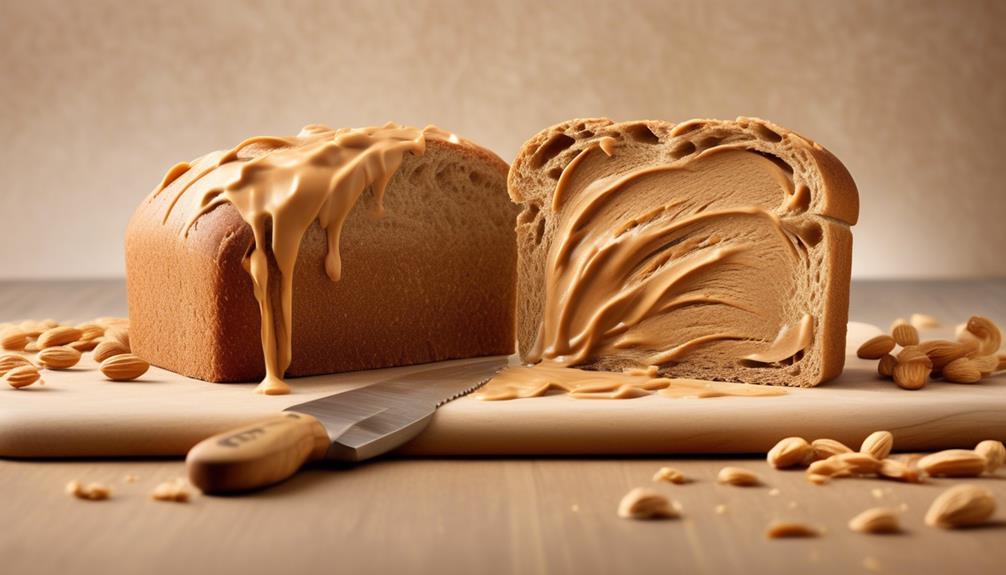We’ve all heard the expression “you can catch more flies with honey than with vinegar,” but were you aware that the average American consumes around 3 pounds of peanut butter annually?
It's a curious statistic that prompts us to ponder the significance of peanut butter in our lives, particularly within the context of relationships.
Peanut butter holds a unique place in the realm of romantic partnerships, serving as a symbolic representation of shared preferences, compromise, and understanding.
But what does peanut butter truly signify in the complex landscape of relationships, and how does it influence the dynamics between two individuals?
Key Takeaways
- Peanut butter symbolizes comfort and familiarity in a relationship, reminding partners of carefree times and creating shared memories.
- Understanding and respecting each other's preferences strengthens the bond in a relationship, leading to balance and harmony.
- Symbiotic relationships, like the one represented by peanut butter, provide emotional and practical support, fostering comfort and security.
- Adaptability, flexibility, and effective communication are crucial in a relationship, allowing for compromise, resolving conflicts, and creating a resilient connection.
Comfort and Familiarity

How does peanut butter contribute to creating a sense of comfort and familiarity in a relationship?
Well, peanut butter is like a warm hug in a jar. It's a simple pleasure that brings us back to our childhood, when things were easy and carefree.
When we share peanut butter and jelly sandwiches, it's not just about the food; it's about sharing memories and creating new ones together.
The familiar taste and texture of peanut butter can soothe our souls and transport us to a place of safety and security.
In a relationship, this sense of comfort and familiarity is vital. It's like having a constant source of reassurance and stability amidst life's uncertainties.
The act of sharing a jar of peanut butter becomes a symbol of our willingness to let our guard down and be vulnerable with each other.
It fosters a connection that's rooted in simplicity and genuine affection.
Shared Preferences

Shared Preferences play a crucial role in strengthening the bond between partners, as they encompass the common likes, dislikes, and choices that contribute to shared experiences and mutual enjoyment. When it comes to shared preferences, my partner and I've found that they go beyond simple likes and dislikes.
Here are a few insights we've discovered along the way:
- Understanding and Respect: Acknowledging and respecting each other's shared preferences, such as whether to indulge in smooth or crunchy peanut butter, can lead to a deeper connection and a more harmonious relationship. It's about appreciating each other's individuality and finding a middle ground.
- Compromise and Balance: Acknowledging and compromising on differing shared preferences is crucial. For instance, if one of us loves crunchy peanut butter and the other prefers smooth, finding a compromise or alternating between the two can contribute to a balanced and respectful partnership.
- Enhanced Shared Experiences: Embracing shared preferences can lead to enhanced shared experiences. Whether it's trying out new foods, exploring hobbies together, or discovering new places to visit, aligning our preferences has allowed us to create meaningful and enjoyable moments together.
Symbiotic Relationship

We all long for relationships that provide us with support and growth, where we can rely on each other for mutual benefit. Symbiotic relationships are like a tightly woven fabric, where our lives are intertwined, and our well-being is interconnected.
In these relationships, we contribute to each other's success and happiness, fostering a bond built on understanding, cooperation, and shared goals.
Mutual Dependence
In a symbiotic relationship, partners rely on each other for emotional, practical, and sometimes, financial support, fostering a dynamic of mutual dependence and interconnectedness. This type of relationship involves a give-and-take dynamic, where both partners contribute to each other's well-being, fostering mutual growth and interdependence.
Within this context, peanut butter in a relationship can be seen as a symbol of our interconnectedness, representing the way in which we rely on each other for support and nourishment. It signifies the give-and-take nature of mutual dependence, where partners find strength and fulfillment in their interconnection.
In a symbiotic relationship, the reliance on each other for various forms of support becomes a source of comfort and security, deepening the bond between partners.
Interconnected Bond
Establishing a symbiotic relationship entails fostering a connection based on interdependence and mutual support, creating a unified unit where both partners contribute to each other's well-being.
This interconnected bond mirrors the way peanut butter and jelly come together to form a delightful and satisfying combination.
In this type of relationship, we prioritize the growth and happiness of both partners. We rely on each other for emotional and practical support, creating a mutually nourishing and supportive connection. It's about being there for each other, understanding each other's needs, and working together as a team.
Just like the way peanut butter complements jelly, partners in a symbiotic relationship bring out the best in each other, creating a harmonious and fulfilling bond that enriches both individuals.
Adaptability and Flexibility

We all know that relationships require adaptability and flexibility. It's about being able to adjust to the changes and challenges that come our way.
Understanding how to navigate these dynamics, communicate effectively, and make compromises is key to maintaining a healthy and thriving relationship.
Relationship Dynamics
Understanding and respecting each other's preferences, such as the choice of peanut butter, serves as a tangible reflection of the adaptability and flexibility crucial for nurturing a harmonious relationship.
In the context of relationship dynamics, being adaptable and flexible involves more than just accommodating different preferences. It also requires open communication, willingness to compromise, and a genuine effort to understand each other's viewpoints.
The ability to adapt and be flexible in decision-making plays a significant role in resolving conflicts and maintaining harmony. This adaptability fosters mutual growth, deepens understanding, and strengthens the connection between partners.
Embracing flexibility in the little things, such as the kind of peanut butter we prefer, paves the way for a more resilient and intimate relationship.
Communication and Compromise
Navigating communication and compromise in a relationship requires active listening and a genuine willingness to understand and validate each other's perspectives. Just as peanut butter and jelly complement each other, effective communication and compromise are essential for a harmonious relationship.
It's crucial to create a safe space where both partners feel heard and understood. This involves not only speaking openly but also actively listening to each other's thoughts and feelings.
When it comes to compromise, it's about finding a middle ground that honors both individuals' needs and desires. Flexibility is key, as it allows for adjustments and understanding from both sides. Remember, compromise doesn't mean sacrificing your core values, but rather finding solutions that work for both partners.
Understanding Personal Differences
When considering personal differences in a relationship, adaptability and flexibility play a crucial role in fostering understanding and harmony. It's like finding the right balance of peanut butter in a relationship – some like it smooth, some prefer it crunchy, but compromising on the texture can make both parties satisfied.
Here's how adaptability and flexibility can enhance your relationship:
- Acknowledge Differences: Embrace the uniqueness of each other's preferences and perspectives, just like how peanut butter complements jelly.
- Open Communication: Discuss how personal differences can be integrated into shared experiences, like blending peanut butter into a smoothie.
- Mutual Accommodation: Flexibility allows for meeting halfway, similar to mixing peanut butter with honey for a balanced taste.
Understanding personal differences with adaptability and flexibility can be the key to a fulfilling and harmonious relationship.
Trust and Reliability

Building trust and reliability in a relationship requires consistent and accountable actions that demonstrate dependability and faithfulness. Just like the reliable and trustworthy nature of peanut butter, trust in a relationship is built over time through open, honest communication and fulfilling commitments.
It's about being there for each other, just like peanut butter is always there to complement a snack or a meal. Trust and reliability form the bedrock of a secure and enduring relationship. It's about knowing that your partner will be there for you, just like you can always count on peanut butter to add flavor and comfort to your life.
Dependability and faithfulness aren't just words; they're the actions that build a strong foundation of trust and reliability in a partnership. By consistently demonstrating these qualities, we can create a bond as reliable and comforting as the presence of peanut butter in our lives.
Let's strive to be the peanut butter in our relationships – dependable, faithful, and always there for each other.
Finding Balance

Finding balance in life requires recognizing our priorities and setting boundaries to manage our time, energy, and emotional investment effectively. It's essential to understand that finding balance is like creating a peanut butter sandwich – it requires the right mix of ingredients to achieve harmony.
Here's how we can achieve this:
- Prioritize with Purpose
Identifying what truly matters in our personal, professional, and relationship spheres is crucial. Just like spreading the right amount of peanut butter on a sandwich, we need to allocate our time and energy intentionally.
- Establish Healthy Boundaries
Setting boundaries helps us maintain equilibrium. Much like the edges of a sandwich hold everything together, boundaries ensure that we allocate time and energy appropriately.
- Nurture Self-Care
Just as a peanut butter sandwich needs to be made with care, we must prioritize our physical, emotional, and mental well-being. This self-nurturing is essential for maintaining balance in all aspects of life.
When we understand the art of finding balance, like making a perfect peanut butter sandwich, we can savor the richness of life without feeling overwhelmed.
Navigating Differences

Navigating differences in a relationship is akin to adjusting the amount of peanut butter on a sandwich; it requires finesse and understanding to maintain the perfect balance. Just like choosing between chunky or creamy peanut butter, navigating differences means finding a middle ground that satisfies both partners.
It's essential to recognize that we all have our own unique perspectives, preferences, and ways of doing things. It's not about erasing those differences but rather learning to appreciate and integrate them into the relationship.
When it comes to creamy peanut butter, some prefer a smooth and consistent texture, while others enjoy a bit of crunch. Similarly, in relationships, we may have contrasting communication styles, problem-solving approaches, or ways of expressing love. Understanding and accepting these differences is crucial for growth and harmony. It's about actively listening, being open-minded, and showing empathy toward each other's perspectives.
Navigating differences also involves compromise and flexibility. Just as we might compromise on the peanut butter choice for a sandwich, finding compromises in a relationship means being willing to meet halfway and make adjustments for the well-being of the partnership. It requires patience, understanding, and a willingness to embrace the beautiful complexities that come with being in a relationship.
Nurturing and Nourishing

Nurturing and nourishing a relationship involves understanding and honoring the unique ways in which we can express love and care for our partner, akin to the thoughtful choices we make when preparing a peanut butter sandwich. When it comes to nurturing a relationship, there are important factors to consider:
- Understanding Preferences: Just as we take into account our partner's peanut butter preferences, nurturing a relationship means understanding and respecting their likes and dislikes in all aspects of life.
- Consistent Acts of Love: Nurturing a relationship involves consistently showing love and care, much like the regularity of enjoying a peanut butter sandwich. Small, thoughtful acts can have a significant impact.
- Adaptability and Flexibility: Much like accommodating different preferences for types of peanut butter, nurturing a relationship involves being adaptable and flexible, willing to embrace change and compromise for the happiness of our partner.
Understanding and integrating these aspects into our relationships can create a nurturing environment that allows love to flourish and grow. Just as selecting the right peanut butter can make a sandwich perfect, nurturing a relationship in these ways can make it strong and fulfilling.
Creating Joyful Moments

Let's talk about the importance of shared laughter and fun in a relationship.
We all deserve to build happy memories with our partners, and creating joyful moments can strengthen the bond between us.
Finding simple ways to bring joy into our everyday lives can make a big difference in our relationship.
Shared Laughter and Fun
Engaging in activities that bring laughter and joy helps us build a positive and lighthearted atmosphere in our relationship, strengthening our bond and fostering a sense of connection and intimacy.
When we share laughter and fun with our partner, it creates joyful moments that serve as a reminder of the happiness and lightness within our relationship. These shared experiences become cherished memories that we can look back on, deepening our connection and understanding of each other.
Additionally, embracing shared laughter and fun contributes to a fulfilling and enjoyable partnership, adding a sense of playfulness and spontaneity to our daily lives.
This shared joy and laughter also helps us navigate through challenges and conflicts, reminding us of the love and happiness we share.
- Shared laughter and fun create cherished memories and deepen our connection.
- Embracing joy and laughter adds playfulness and spontaneity to our relationship.
- Shared laughter helps us navigate through challenges and conflicts.
Building Happy Memories
Establishing cherished traditions and creating joyful memories are vital for nurturing a deep and meaningful connection in a relationship. From simple rituals like Sunday morning breakfasts to annual getaways, these traditions create a sense of security and togetherness.
Trying new experiences together, whether it's a cooking class or a hiking adventure, builds a treasure trove of shared joyful moments. Celebrating milestones and achievements as a couple reinforces the bond and leaves lasting imprints of happiness. Keeping tangible reminders, like photographs or mementos, helps preserve these joyful memories for the long haul.
Expressing gratitude for these moments not only deepens the emotional connection but also solidifies the foundation of happiness in the relationship. By consciously building these happy memories, we can foster a love that's rich with shared experiences and joyful moments.
Overcoming Sticky Situations

Overcoming sticky situations in a relationship requires genuine empathy and a willingness to navigate through challenges together, fostering a deeper understanding and connection. It's essential to approach these moments with an open heart and mind, recognizing that both individuals are unique with their own set of preferences and values.
Here's how we can overcome sticky situations in relationships:
- Open Communication: Engage in honest and respectful conversations to understand each other's perspectives and arrive at mutually beneficial solutions.
- Share your feelings and thoughts openly, creating a safe space for both partners to express themselves without judgment.
- Practice active listening, showing genuine interest in understanding your partner's point of view.
- Finding Common Ground: Look for areas where compromise is possible, acknowledging that differences can coexist harmoniously.
- Identify shared goals and values, using them as a foundation for finding common ground in challenging situations.
- Embrace flexibility and openness to new ideas, allowing room for growth and unity in the relationship.
- Long-Term Compatibility: Consider the peanut butter incident as a catalyst for discussing long-term compatibility.
- Reflect on how the resolution of such situations can impact the overall health and sustainability of the relationship.
- Use these moments as opportunities to deepen your understanding of each other, strengthening the bond and connection.
Uniting in Diversity

As we navigate the complexities of relationships, embracing our differences and finding common ground is essential.
It's about acknowledging and respecting each other's unique perspectives, beliefs, and experiences.
Embracing Differences Together
Embracing our differences together enriches our relationship and fosters personal growth.
- Open Communication: Actively listening and sharing our thoughts and feelings allows us to understand and appreciate each other's unique perspectives.
- Common Ground: Finding shared values and goals strengthens our bond while respecting each other's individuality.
- Mutual Respect and Empathy: Valuing each other's differences and experiences creates a supportive and inclusive environment for personal development.
Embracing Differences Together (Uniting in Diversity) means recognizing that our relationship is enhanced by the diverse qualities we bring. It's about learning from each other, growing together, and embracing the richness that comes from our unique backgrounds and viewpoints. Our willingness to celebrate and understand these differences lays the foundation for a deeper, more fulfilling connection.
Finding Common Ground
How can we actively seek common ground while honoring and celebrating the diverse perspectives and values that each of us brings to the relationship? Finding common ground involves embracing our differences and recognizing that they enrich our relationship. It's about creating an environment of inclusivity, where we both feel valued and understood. To achieve this, effective communication and compromise are essential. Here's a practical way to approach this:
| Shared Interests and Values | Respecting Uniqueness | Effective Communication |
|---|---|---|
| Identify activities or beliefs we both value | Acknowledge and appreciate each other's unique qualities | Create a safe space for open and honest communication |
| Find ways to integrate these into our relationship | Encourage individual growth and expression | Actively listen and validate each other's perspectives |
| Use them as a foundation for bonding and understanding | Embrace the diversity that each of us brings | Seek solutions together through compromise and understanding |
Expressing Vulnerability

Sharing our fears, insecurities, and weaknesses with our partner can be a powerful way to deepen the emotional intimacy and connection in our relationship. It's not easy to be vulnerable, but it's an essential part of building a strong and healthy connection with our partner.
Here are some insights to consider:
- Building Trust: When we express vulnerability, we show our partner that we trust them with our deepest thoughts and emotions. This act of trust can strengthen the bond between us.
- Emotional Intimacy: By sharing our vulnerabilities, we invite our partner to understand and empathize with our innermost feelings. This fosters a deeper emotional connection and allows us to feel truly seen and understood.
- Creating a Safe Space: It's important to create a supportive and non-judgmental environment where both partners feel safe to express their vulnerabilities. This safe space allows for open and honest communication, fostering a sense of security in the relationship.
Expressing vulnerability is a courageous step that can lead to greater understanding and empathy within a relationship. It's a way for both partners to show their authentic selves and cultivate a deeper sense of intimacy and connection.
Building a Strong Foundation

To build a strong foundation in a relationship, it's essential to prioritize open and honest communication, as it forms the bedrock of understanding and connection between partners.
When we openly share our thoughts, feelings, and experiences with our partner, it fosters trust and strengthens the bond between us.
It's important to create a safe space where both partners feel comfortable expressing themselves without fear of judgment. Trust and honesty are the cornerstones of a solid relationship foundation.
Respecting each other's individuality and boundaries is also crucial. Understanding and acknowledging each other's unique perspectives and needs can help cultivate a healthy and supportive environment.
Additionally, aligning on shared values and goals lays a sturdy groundwork for the relationship, providing a sense of unity and purpose.
Mutual support and empathy further contribute to the strength of the foundation, creating a nurturing environment where both partners can thrive.
Growth and Evolution

What are the key elements to fostering growth and evolution in a relationship, and how can they be effectively implemented to support the changing dynamics and needs of both partners?
- Open and Honest Communication
- Regularly discuss individual growth, aspirations, and how the relationship can adapt to support these changes.
- Create a safe space for sharing fears, doubts, and desires for personal evolution.
- Encourage vulnerability and active listening to truly understand each other's evolving perspectives.
- Embracing Change Together
- Recognize that personal growth may lead to shifts in priorities and perspectives.
- Approach changes with curiosity and a willingness to adapt, rather than fear or resistance.
- Work together to find new ways to connect and support each other as you both evolve.
- Learning and Adapting
- Acknowledge that overcoming challenges and learning from mistakes is crucial for growth.
- Embrace a growth mindset, where challenges are seen as opportunities for learning and strengthening the relationship.
- Continuously adapt strategies for communication, intimacy, and support to align with each partner's evolving needs.
Navigating growth and evolution in a relationship requires compassion, understanding, and a shared commitment to individual and collective growth. It's a journey that demands patience, flexibility, and unwavering support for each other's personal development.
Frequently Asked Questions
What Does Peanut Mean in a Relationship?
In relationships, seemingly trivial preferences like peanut butter can reveal deeper compatibility. Understanding and respecting each other's likes and dislikes fosters a sense of empathy and consideration.
It's about more than just food; it's a reflection of how we approach differences and compromise. It's an opportunity to learn and grow together, building a stronger connection.
Peanut butter can symbolize the little things that make a relationship work.
What Is the Meaning of Peanut Butter?
Peanut butter, to us, is more than just a spread. It embodies the little gestures that nurture a relationship. It's about understanding and appreciating each other's quirks.
When shared, it signifies a connection and a sense of unity. In essence, it represents finding harmony in our differences. It's a reminder that the small things we share can impact the bigger picture of our relationship.
What Does It Mean When Someone Says You Are the Peanut Butter to My Jelly?
We understand the significance of being told 'you are the peanut butter to my jelly.' It communicates a deep bond, symbolizing perfect compatibility and a harmonious blend of personalities.
This phrase suggests a sense of comfort, stability, and satisfaction in a relationship. When someone compares you to peanut butter, it implies that you're an essential and cherished part of their life, bringing sweetness and balance to the connection.
What Does Peanut Butter and Jelly Mean Jealous?
Peanut butter and jelly represent a classic combination symbolizing harmony and compatibility. When applied to relationships, these flavors can signify the balance and unity between partners. Different preferences may not mean jealousy, but rather individuality coming together to create something beautiful.
Understanding and accepting each other's differences is key to a healthy relationship. Just like peanut butter and jelly, we can complement each other without losing our unique flavors.
Conclusion
In conclusion, peanut butter in a relationship is like two peas in a pod. It represents the compatibility, understanding, and compromise needed for a successful partnership. It's about finding comfort and familiarity, respecting each other's preferences, and being adaptable and flexible.
By building a strong foundation and growing together, peanut butter symbolizes the trust, reliability, and unity essential for a thriving relationship. It's the little things that matter, and peanut butter reminds us to appreciate and embrace our differences.









